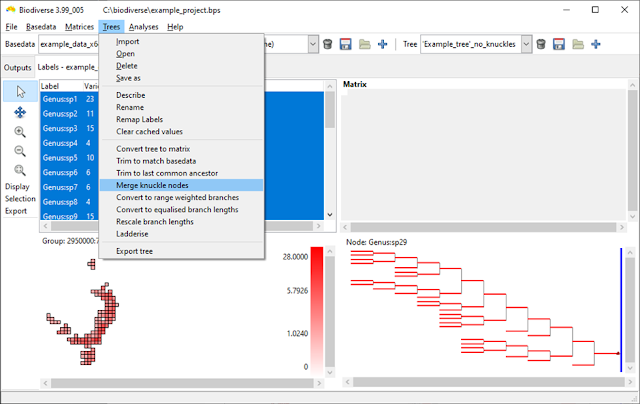When Biodiverse is used to trim a tree to a subset of branches, for example to match the selected BaseData object, any branch with no remaining descendants is removed from the tree. All other branches are retained.
What this means is that some internal branches (nodes) can be left with only one child branch (node),. These can be referred to as single-child nodes and also knuckles. Retaining such nodes can be useful if some of the structure of the original tree needs to be kept, for example to indicate that there is phylogenetic data but that it has been removed from the tree. The counter to this is that most phylogenetic trees are samples and so are likely to be missing many branches anyway.
In the spirit of letting the user decide, Biodiverse version 4 supports the merger of internal branches with their children if they have only one child.
Names are important, and like many systems any node can be named in Biodiverse. In fact, all nodes have names but internal nodes default to a number with three trailing underscores (so "1___", "35___" etc). This allows many of the branch and clade level indices such as the phylogenetic endemism clade contributions and PD clade loss.
The general rule when merging is that the name of the merged node is whichever node had a non-default name to begin with. If both have non-default names then a child that is a terminal wins. Otherwise the parent name is used.
The process is best demonstrated using images.
 |
| An example tree plotted using depth instead of length to show the individual branches. The black branches are not in the basedata. |
 |
| The tree trimming interface includes the option to merge single child nodes. In this case it is not selected. |
 |
| The black branches from the previous screenshot have been deleted but one can see several branches that appear twice as long as the others. These are actually pairs of branches. |
 |
| Repeating the process above but this time merging the single child (knuckle) nodes. |
 |
| In this case all the branches are the same length because all single child branches have been merged with their children. |
The examples above all use the tree trimming process, but if you have a tree that already has knuckles or forget to merge them then you can also merge the nodes directly from the tree menu.
 |
| Direct access to the merging process. |
Shawn Laffan
25-Nov-2022
For more details about Biodiverse, see http://shawnlaffan.github.io/biodiverse/
To see what else Biodiverse has been used for, see https://github.com/shawnlaffan/biodiverse/wiki/PublicationsList
You can also join the Biodiverse-users mailing list at https://groups.google.com/group/Biodiverse-users or start a discussion at https://github.com/shawnlaffan/biodiverse/discussions
No comments:
Post a Comment
Note: only a member of this blog may post a comment.